Articles
- Page Path
- HOME > J Korean Acad Nurs > Volume 41(2); 2011 > Article
-
Original Article
- Meta Analysis of Variables Related to Attention Deficit Hyperactivity Disorder in School-Age Children
- Wan Ju Park, Ji Yeong Seo, Mi Ye Kim
-
Journal of Korean Academy of Nursing 2011;41(2):256-268.
DOI: https://doi.org/10.4040/jkan.2011.41.2.256
Published online: April 30, 2011
1Assistant Professor, College of Nursing, Kyungpook National University, Daegu, Korea.
2Full-time Lecturer, Department of Nursing, Youngnam Foreign Language College, Gyeongsan, Korea.
3Professor, College of Nursing, Kyungpook National University, Daegu, Korea.
- Address reprint requests to: Seo, Ji Yeong. Department of Nursing, Youngnam Foreign Language College, 220-1 Hyeopseok-ri, Namcheon-myeon, Gyeongsan 712-717, Korea. Tel: +82-53-810-7763, Fax: +82-53-810-0199, marseo@hanmail.net
© 2011 Korean Society of Nursing Science
Abstract
-
Purpose
- The purpose of this study was to use meta-analysis to examine recent domestic articles related to attention deficit hyperactivity disorder (ADHD) in school-age children.
-
Methods
- After reviewing 213 articles published between 1990 and 2009 from and cited in RISS, KISS, and DBpia, the researchers identified 24 studies with 440 research variables that had appropriate data for methodological study. SPSS 17.0 program was used. The outcome variables were divided into five types: Inattention, hyperactive impulsive, intrinsic, extrinsic, and academic ability variables.
-
Results
- Effects size of overall core symptoms was 0.47 which is moderate level in terms of Cohen criteria and effects size of overall negative variables related ADHD was 0.27 which is small level. The most dominant variable related to ADHD was obtained from hyperactive-impulsive (0.70). Also academic ability (0.45), inattention (0.37), and intrinsic variables (0.29) had a small effect whereas extrinsic variables (0.13) had little effect on descriptive ADHD study.
-
Conclusion
- The results reveal that ADHD core symptoms have moderate effect size and peripheral negative variables related ADHD have small effect size. To improve the reliability of the meta-analysis results by minimizing publication bias, more intervention studies using appropriate study designs should be done.
- 1. Biederman J, Kwon A, Aleardi M, Chouinard VA, Marino T, Cole H, et al. Absence of gender effects on attention deficit hyperactivity disorder: Findings in nonreferred subjects. The American Journal of Psychiatry. 2005;162:1083–1089.ArticlePubMed
- 2. Centers for Disease Control and Prevention. Diagnosed attention deficit hyperactivity disorder and learning disability: United States, 2004-2006. Vital and Health Statistics. 2008;07;Retrieved August 10, 2010. 10(237):1–22. from http://www.cdc.gov/nchs/data/series/sr_10/Sr10_237.pdf.
- 3. Chang EJ. A preliminary study of a school-based intervention for attention-deficit hyperactive children. Journal of Yeolin Education. 2005;13(1):63–84.
- 4. Cho SC. Attention-deficit hyperactivity disorder. 2001;Seoul, Seoul National University Press.
- 5. Cohen J. Statistical power analysis for the behavioral science. 1988;2nd ed. New Jersey, Lawrence Erlbaum.
- 6. DuPaul GJ, Barkley RA, Connor DF. Barkely R.A. Stimulants. In: Attention deficit hyperactivity disorder: A handbook for diagnosis and treatment. 1998;2nd ed. New York, Guilford Press. 510–551.
- 7. Eun KS, Ryu SY, Jung CH. Distribution change of child and adolescent psychiatric outpatients at a university hospital in Daegu. Journal of the Korean Society of Biological Therapies in Psychiatry. 2005;11:78–88.
- 8. Gaub M, Carlson CL. Gender differences in ADHD: A meta-analysis and critical review. Journal of the American Academy of Child and Adolescent Psychiatry. 1997;36:1036–1045.ArticlePubMed
- 9. Hedges LV, Olkin I. Regression models in research synthesis. The American Statistician. 1983;37:137–140.Article
- 10. Jeong YC, Lee JB, Park HB, Cheung SD, Sung HM, Sakong JK. Developmental changes of children with attention deficit hyperactivity disorder. Journal of the Korean Society of Biological Therapies in Psychiatry. 2001;7(1):137–146.
- 11. Kessler RC, Adler L, Barkley R, Biederman J, Conners CK, Demler O, et al. The prevalence and correlates of adult ADHD in the United States: Results from the national comorbidity survey replication. American Journal of Psychiatry. 2006;163:716–723.ArticlePubMed
- 12. Kim MD. Research trend of ADHD: Based on the articles in KRH registered (proposed) journal of related to special education. Journal of Emotional & Behavioral Disorders. 2008;24:279–299.
- 13. Lee HL, Hwang ST. Clinical study of child and adolescent psy-chiatric outpatients. Journal of Child & Adolescent Psychiatry. 1996;7(1):14–22.
- 14. Lee JB, Bae JW, Cheung SD, Kim JS, Seo WS, et al. The clinical characteristics of child and adolescent with attention deficit or hyperactivity. Journal of Korean Neuropsychiatric Association. 2003;42:231–245.
- 15. Lee SJ, Ha EH, Oh KJ. Discriminating of ADHD children with K-CBCL subscales. Korean Journal of Clinical Psychology. 2008;27:191–207.
- 16. Littman EB. ADHD underdiagnosed in girls. Family Practice News. 2000;Retrieved April 1, 2000. from http://www.highbeam.com/doc/1G1-62050618.html.
- 17. Majewicz-Hefley A, Carlson JS. A meta-analysis of combined treatments for children diagnosed with ADHD. Journal of Attention Disorders. 2007;10:239–250.ArticlePubMedPDF
- 18. Nylund D. Kim MH . Treating huckleberry finn. 2008;Seoul, Inner Books. (Original work published 2002).
- 19. Orwin RG. A fail-safe N for effect size. Journal of Educational Statistics. 1983;8:157–159.ArticlePDF
- 20. Park JH, Kim YH. Analysis of relationship to the enjoyment for physical activity and the rate, on the sex and the age, of ADHD children in DSM-IV-TR. Korean Journal of Physical Education. 2008;47:801–809.
- 21. Seo JY, Park WJ. The meta analysis of trends the effects of non-pharmacological intervention for school aged ADHD children. Journal of Korean Academy of Psychiatric and Mental Health Nursing. 2010;19:117–132.
- 22. Silver LB. Attention deficit-hyperactivity disorder: Is it a learning disability or a related disorder? Journal of Learning Disabilities. 1990;23:394–397.ArticlePubMedPDF
- 23. Van der Oord S, Prins PJ, Oosterlaan J, Emmelkamp PM. Efficacy of methylphenidate, psychosocial treatments and their combination in school-aged children with ADHD: A meta-analysis. Clinical Psychology Review. 2008;28:783–800.ArticlePubMed
- 24. Wolraich ML, Wibbelsman CJ, Brown TE, Evans SW, Gotlied EM, Knight JR, et al. Attention-deficit/hyperactivity disorder among adolescents: A review of the diagnosis, treatment, and clinical implications. Pediatrics. 2005;115:1734–1746.ArticlePubMedPDF
REFERENCES
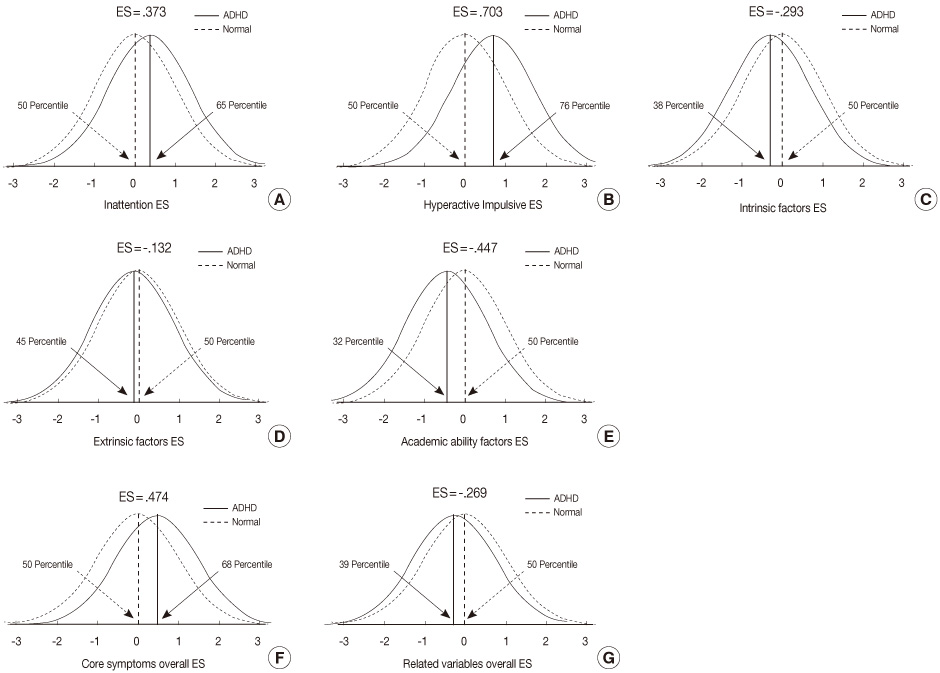

Figure & Data
REFERENCES
Citations

- Associations between Dietary Intake and Attention Deficit Hyperactivity Disorder (ADHD) Scores by Repeated Measurements in School-Age Children
Su-a Ryu, Yean-Jung Choi, Hyojin An, Ho-Jang Kwon, Mina Ha, Yun-Chul Hong, Soo-Jong Hong, Hyo-Jeong Hwang
Nutrients.2022; 14(14): 2919. CrossRef
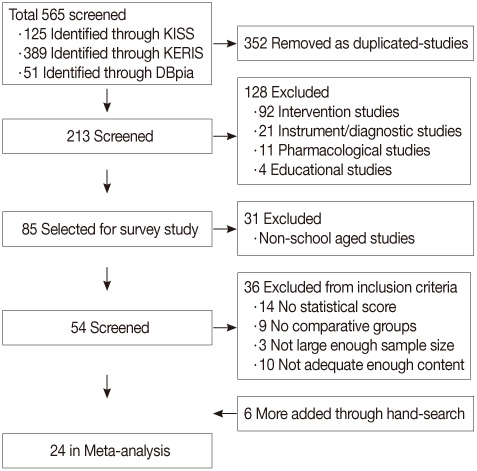


Figure 1
Figure 2
Figure 3
Summary of Characteristics of ADHD Studies (N=24)
Elem=elementary school; gr=grade; AP=attention problem; HI=hyperactivity/impulse; IF=intrinsic factors; EF=extrinsic factors; AA=academic ability; ADHD-I=predominantly inattentive type; ADHD-HI=predominantly hyperactive-impulsive type.
Effect Size of Target Outcome Variables according to Overall Subjects
AP=attention problem; HI=hyperactivity/Impulse; IF=intrinsic factors; EF=extrinsic factors; AA=academic ability.
Effect Size of Target Outcome Variables according to General Characteristics
ADHD-I=predominantly inattentive type; ADHD-HI=predominantly hyperactive-impulsive type; ADHD-C=combined type; AP=attention problem; HI=hyperactivity/Impulse; IF=intrinsic factors; EF= extrinsic factors; AA=academic ability.
Effect Size of Diagnosis, Treatment and Subtypes according to Grades
ADHD-I=predominantly inattentive type; ADHD-HI=predominantly hyperactive-impulsive type; ADHD-C=combined type; AP=attention problem; HI=hyperactivity/Impulse; IF=intrinsic factors; EF=extrinsic factors; AA=academic ability.
Effect Size of Subtypes according to Diagnosis and Treatment
ADHD-I=predominantly inattentive type; ADHD-HI=predominantly hyperactive-impulsive type; ADHD-C=combined type; AP=attention problem; HI=hyperactivity/Impulse; IF=intrinsic factors; EF=extrinsic factors; AA=academic ability.
Elem=elementary school; gr=grade; AP=attention problem; HI=hyperactivity/impulse; IF=intrinsic factors; EF=extrinsic factors; AA=academic ability; ADHD-I=predominantly inattentive type; ADHD-HI=predominantly hyperactive-impulsive type.
AP=attention problem; HI=hyperactivity/Impulse; IF=intrinsic factors; EF=extrinsic factors; AA=academic ability.
ADHD-I=predominantly inattentive type; ADHD-HI=predominantly hyperactive-impulsive type; ADHD-C=combined type; AP=attention problem; HI=hyperactivity/Impulse; IF=intrinsic factors; EF= extrinsic factors; AA=academic ability.
ADHD-I=predominantly inattentive type; ADHD-HI=predominantly hyperactive-impulsive type; ADHD-C=combined type; AP=attention problem; HI=hyperactivity/Impulse; IF=intrinsic factors; EF=extrinsic factors; AA=academic ability.
ADHD-I=predominantly inattentive type; ADHD-HI=predominantly hyperactive-impulsive type; ADHD-C=combined type; AP=attention problem; HI=hyperactivity/Impulse; IF=intrinsic factors; EF=extrinsic factors; AA=academic ability.
 KSNS
KSNS
 E-SUBMISSION
E-SUBMISSION

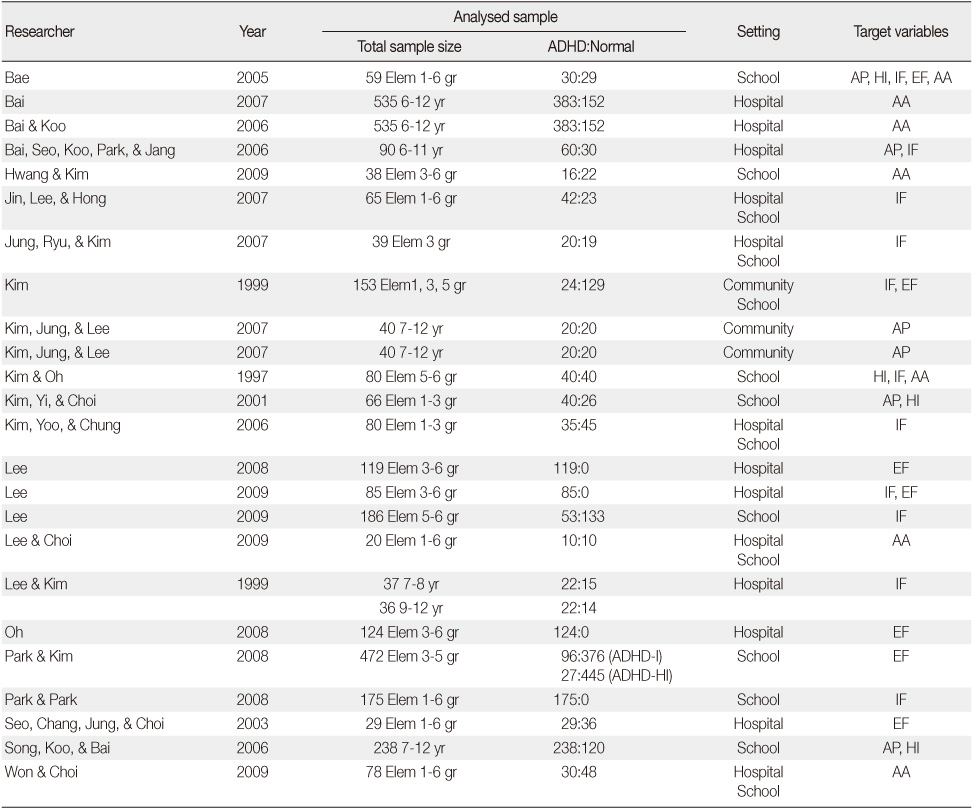

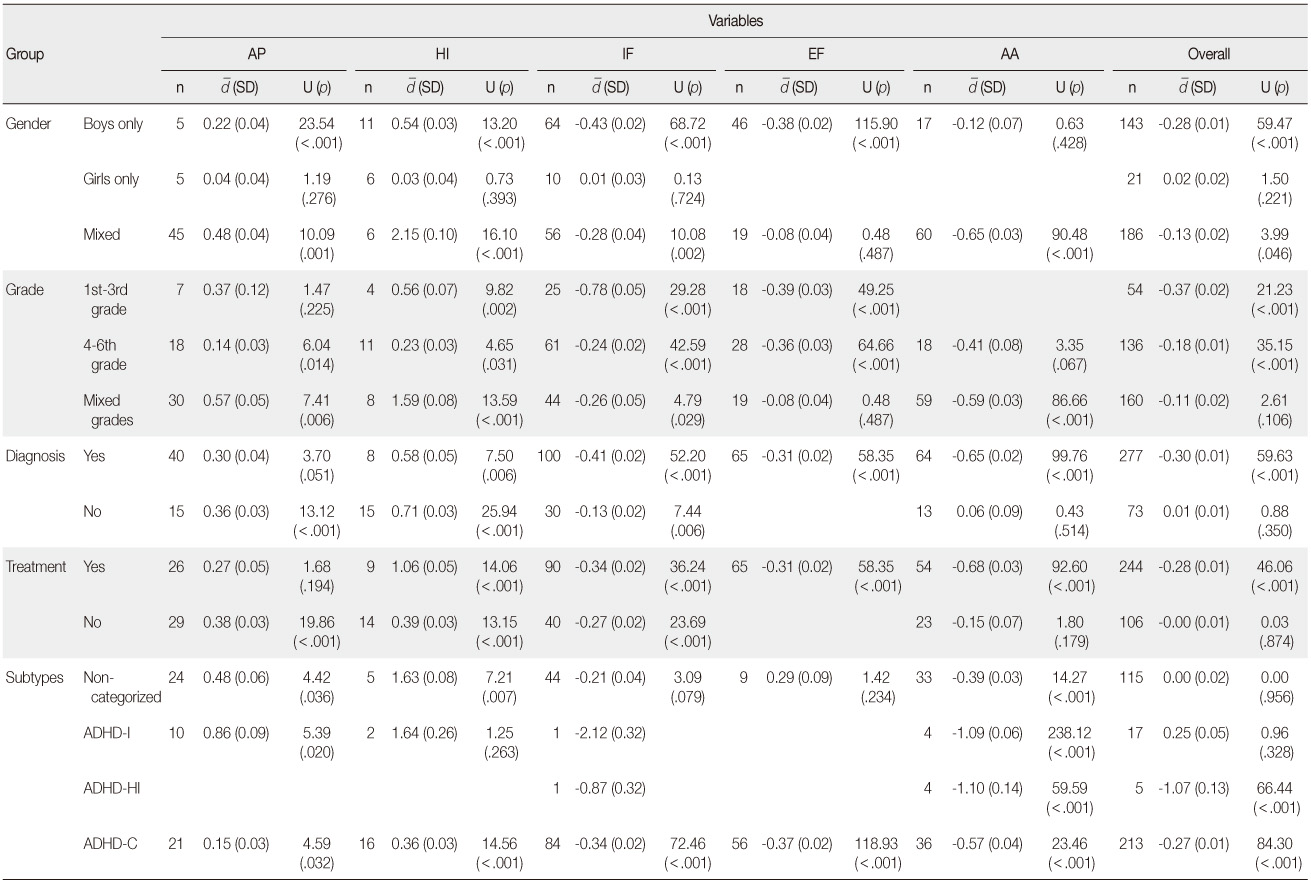

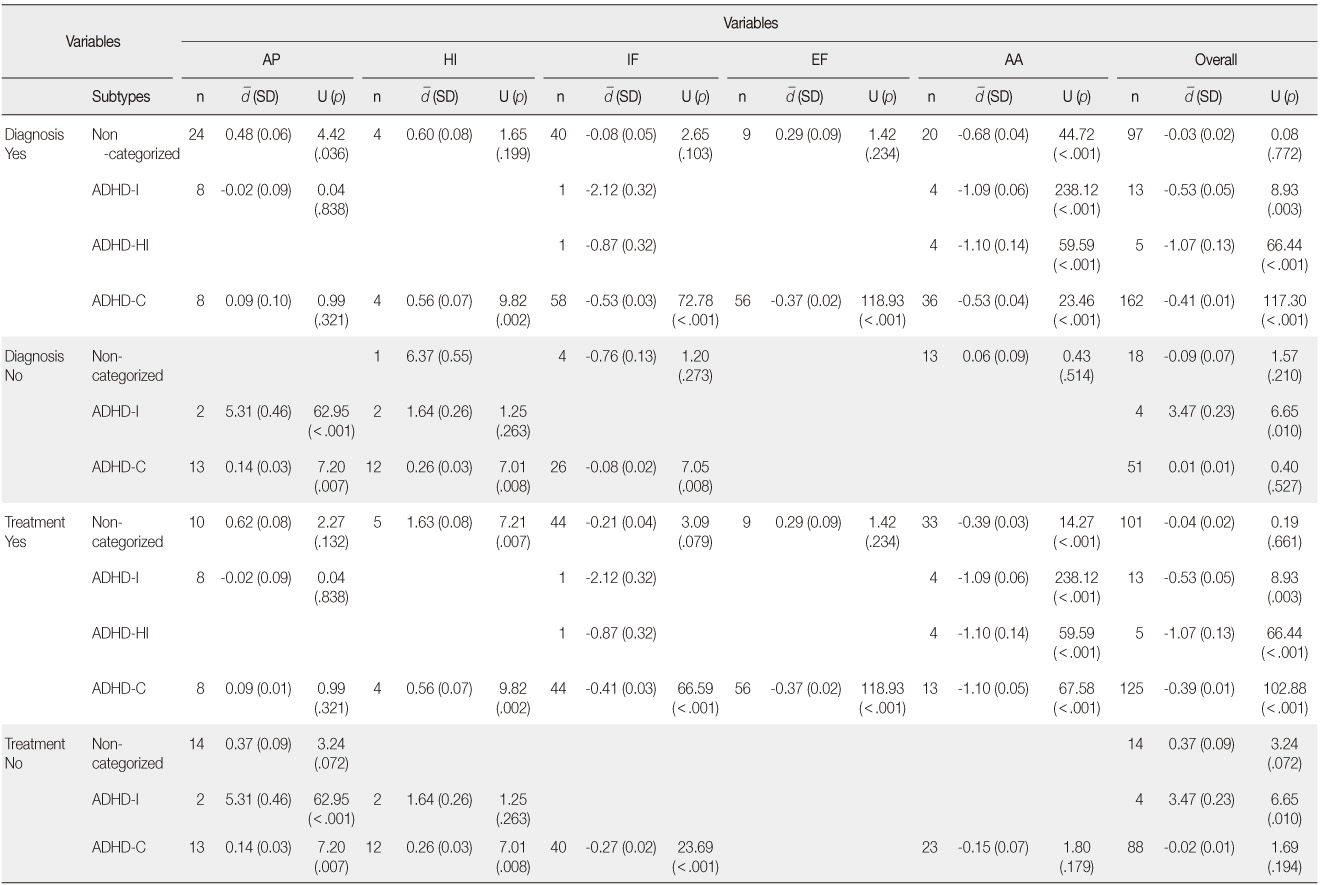
 Cite
Cite

